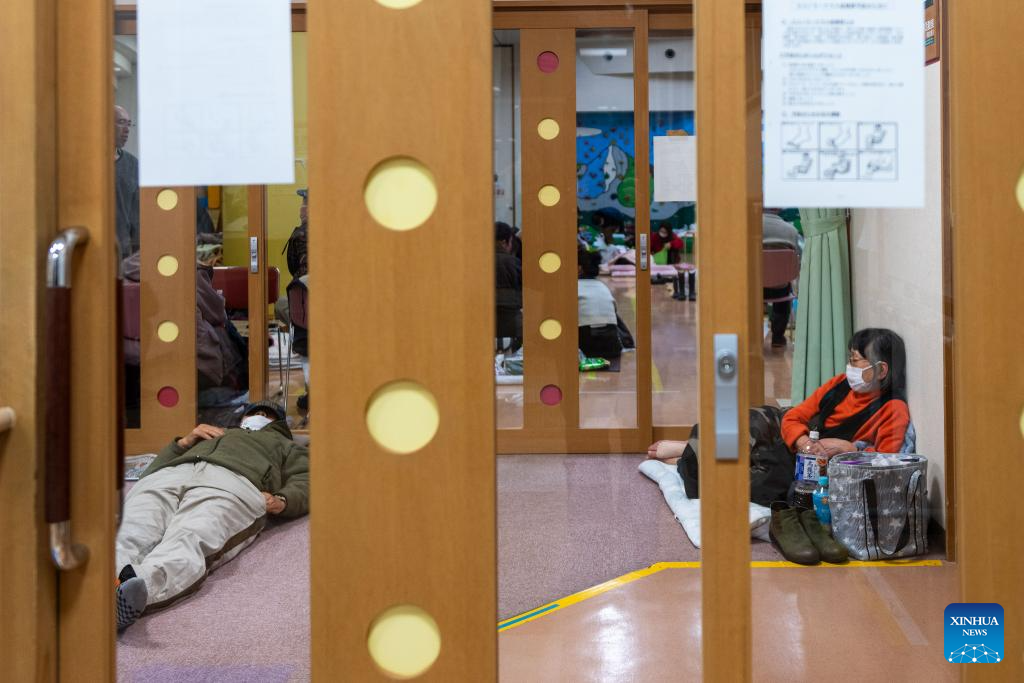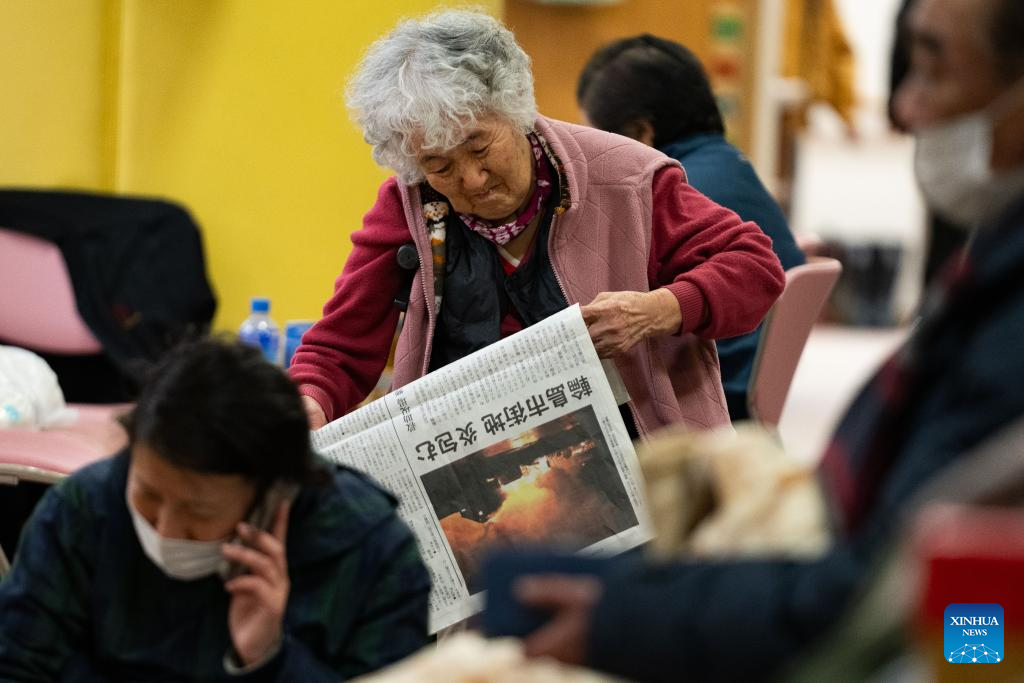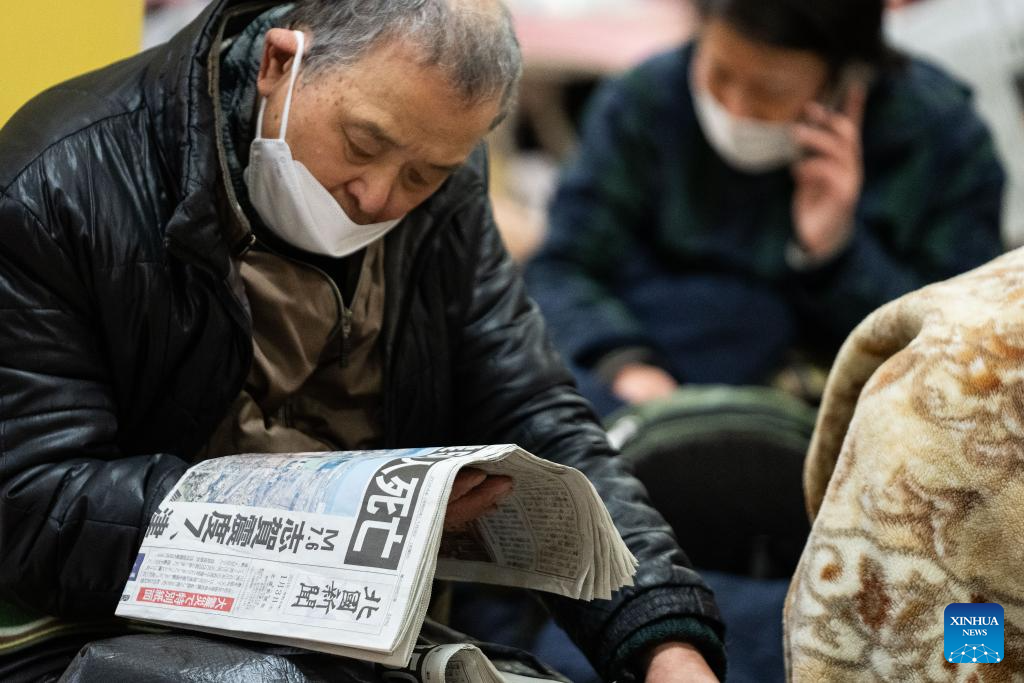
Children are seen at a temporary shelter in Wajima, Ishikawa prefecture, Japan, Jan. 3, 2024. A series of strong earthquakes, with a major one of 7.6 magnitude, on Monday struck at a shallow depth in the Noto region of Ishikawa prefecture. To date, 22 temporary shelters have been provided to quake-affected people in the most stricken city of Wajima in Ishikawa. (Xinhua/Zhang Xiaoyu)
by Xinhua writers Guo Dan, Zhang Yiyi, Li Guangzheng, Zhang Xiaoyu
TOKYO, Jan. 3 (Xinhua) -- "I am now 79 years old, and this was the largest and most terrifying quake I've ever experienced," a resident from the central Japanese prefecture of Ishikawa recalled the darkest hours he went through when a 7.6-magnitude earthquake struck on Monday.
"The walls of my house collapsed, and as roof tiles kept falling the entire roof was about to disappear," the elderly man told Xinhua while sheltering at Tomi Elementary School in the town of Shika, Hakui city, on Tuesday. "My daughter, granddaughter and I escaped through the sliding windows on the side, and had to spend a trembling night in the car."
A series of strong earthquakes, with a major one of 7.6 magnitude, on Monday struck at a shallow depth in the Noto region of Ishikawa prefecture. The Japan Meteorological Agency (JMA) has officially named it the 2024 Noto Peninsula Earthquake.
Centered around 30 km east-northeast of Wajima, the devastating quake registered a maximum intensity of 7 on Japan's seismic intensity scale, which would make it impossible for people to stand.
According to the JMA, it was the highest-level quake in Ishikawa prefecture since 1885, and the most severe temblor in Japan nationwide since 1995 apart from the 9.0-magnitude earthquake which hit northeast Japan on March 11, 2011.
A JMA expert said that the earthquake, categorized as a seismic swarm, had a length of up to 150 kilometers in the epicenter area, leading to unprecedented scale and shaking intensity.
All means of transportation to the quake-stricken area were disrupted on Monday, and on Tuesday morning, Xinhua reporters flew to an airport approximately 150 km from the hardest-hit Wajima City before driving towards the quake-affected zone.
During the journey, cracks and damage were seen along the road, and at around 40 km from Wajima, the ground displayed crisscrossing cracks every five to 10 meters, some as wide as half a meter. Numerous houses along the road suffered severe roof damage, with a few collapsing entirely, leaving large stone fragments scattered over the roadside.
The reporters were forced to detour at 30 km from Wajima, as the road was completely blocked by large amounts of tree trunks, debris and soil brought down by landslides. However, the road saw another collapse further ahead, making it impassable to reach the city.
On the way to the quake-stricken area, Xinhua reporters witnessed residents heading towards Tomi Elementary School, carrying essential supplies. After the earthquake, the school became a shelter, with every classroom packed with people of all ages lying on the floor.
After the earthquake struck, people gathered here to escape potential tsunamis and stayed as continuous aftershocks rendered many homes unsafe to return to, the person in charge at the shelter told Xinhua.
As of 5:00 p.m. on Tuesday, about 230 people have sought refuge in the school, and water supply is becoming a pressing issue.
"The entire school is without water and its stored disaster-prevention water supply is quite limited. We have been fetching clean water from the nearby river to flush toilets for everyone," a 22-year-old man surnamed Kuida told Xinhua.
Kuida lives nearby and went to the school as a child. "We can't go back home now, and I don't know what will happen in the future now seeing my alma mater turn into such chaos," he said, while aftershocks continued to take place.
Various certificates and trophies in glass display cases at the entrance of the school building had fallen, the wooden corridor at the entrance was crooked, the ground had risen by more than 10 centimeters, and there were significant cracks in the walls.
It was 32 km away from the severely stricken city of Wajima and as the winter night fell, the temperature suddenly dropped.
As the cries of babies and the coughs of the elderly can be heard intermittently inside the school building, the night would undoubtedly be a difficult one for the sheltering residents to sleep through. ■

People rest at a temporary shelter in Wajima, Ishikawa prefecture, Japan, Jan. 3, 2024. A series of strong earthquakes, with a major one of 7.6 magnitude, on Monday struck at a shallow depth in the Noto region of Ishikawa prefecture. To date, 22 temporary shelters have been provided to quake-affected people in the most stricken city of Wajima in Ishikawa. (Xinhua/Zhang Xiaoyu)

People rest at a temporary shelter in Wajima, Ishikawa prefecture, Japan, Jan. 3, 2024. A series of strong earthquakes, with a major one of 7.6 magnitude, on Monday struck at a shallow depth in the Noto region of Ishikawa prefecture. To date, 22 temporary shelters have been provided to quake-affected people in the most stricken city of Wajima in Ishikawa. (Xinhua/Zhang Xiaoyu)

A woman reads about earthquake news at a temporary shelter in Wajima, Ishikawa prefecture, Japan, Jan. 3, 2024. A series of strong earthquakes, with a major one of 7.6 magnitude, on Monday struck at a shallow depth in the Noto region of Ishikawa prefecture. To date, 22 temporary shelters have been provided to quake-affected people in the most stricken city of Wajima in Ishikawa. (Xinhua/Zhang Xiaoyu)

A man reads about earthquake news at a temporary shelter in Wajima, Ishikawa prefecture, Japan, Jan. 3, 2024. A series of strong earthquakes, with a major one of 7.6 magnitude, on Monday struck at a shallow depth in the Noto region of Ishikawa prefecture. To date, 22 temporary shelters have been provided to quake-affected people in the most stricken city of Wajima in Ishikawa. (Xinhua/Zhang Xiaoyu)

People rest at a temporary shelter in Wajima, Ishikawa prefecture, Japan, Jan. 3, 2024. A series of strong earthquakes, with a major one of 7.6 magnitude, on Monday struck at a shallow depth in the Noto region of Ishikawa prefecture. To date, 22 temporary shelters have been provided to quake-affected people in the most stricken city of Wajima in Ishikawa. (Xinhua/Zhang Xiaoyu)

People rest at a temporary shelter in Wajima, Ishikawa prefecture, Japan, Jan. 3, 2024. A series of strong earthquakes, with a major one of 7.6 magnitude, on Monday struck at a shallow depth in the Noto region of Ishikawa prefecture. To date, 22 temporary shelters have been provided to quake-affected people in the most stricken city of Wajima in Ishikawa. (Xinhua/Zhang Xiaoyu)

People rest at a temporary shelter in Wajima, Ishikawa prefecture, Japan, Jan. 3, 2024. A series of strong earthquakes, with a major one of 7.6 magnitude, on Monday struck at a shallow depth in the Noto region of Ishikawa prefecture. To date, 22 temporary shelters have been provided to quake-affected people in the most stricken city of Wajima in Ishikawa. (Xinhua/Zhang Xiaoyu)



